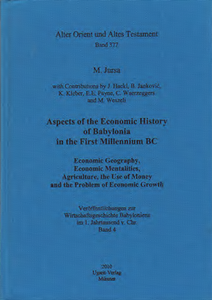
Aspects of the Economic History of Babylonia in the First Millennium BC. Economic Geography, Economic Mentalities, Agriculture, the Use of Money and the Problem of Economic Growth. (AOAT 377)
Michael
Veröffentlichungen zur Wirtschaftsgeschichte im 1. Jahrtausend v. Chr.
ISBN: 978-3-86835-041-8
Pub: 2010
xviii + 900 pp.
Basierend auf 20 Jahre intensiver Forschung stellt Jursa in dieser Untersuchung die zahlreichen Facetten des Wirtschafts im ersten Jahrtausend v. Chr. in Mesopotamien vor. Die Studie basiert auf mehr als 21.500 Tontafeln, die in Kopien oder Transkriptionen zur Verfügung gestellt werden. Basis ist das "Vienna Economic History of Babylon-Projekt", dessen Texte Archiven bestimmter Herkunft
zugeordnet werden können. Der Großteil des Materials stammt aus Babylon,
Borsippa, Nippur, Sippar und Uruk und bezeugt Bewegungen von
Waren und Personen (Kapitel 2), die Strategien innerhalb des lokalen und interregionalen Handels (Kapitel 3) und die Landwirtschaft in den ländlichen Gebieten rund um die Städte (Kapitel 4). Die Texte kommen sowohl aus privaten wie auch Tempel-Archiven. Besonderes Augenmerk wird auf die Entwicklung von Silber als Währung (Kapitel 5) gelegt. Umfangreiche Indizes
ermöglichen einen einfachen Zugang zu der Fülle von Informationen.
Inhalt:
1. Introduction1.1. First millennium Babylonia: historical framework and sources
1.2. Assyriology and economic history
1.3. The Neo-Babylonian economy: the state of the question, problems and models
1.3.1. Ecological zones and the corresponding sectors of the economy / 1.3.2. Modes of exchange / 1.3.3. Overall assessments of the Babylonian economy in the first millennium / 1.3.4. Determinants of economic structure and performance
2. Routes of inner-Babylonian communication and exchange of goods
2.1. Introduction
2.2. Movements of goods and people in the institutional archives
2.2.1. The Euphrates route / 2.2.2. Regional economic networks and ‘satellite cities’ / 2.2.3. Uruk and Sippar and central Babylonia / 2.2.4. Conclusion
2.3. Movements of people and goods in private archives
2.3.1. Opis / 2.3.2. Sippar / 2.3.3. Kish /2.3.4. Cutha / 2.3.5. Borsippa / 2.3.6. Dilbat / 2.3.7. Nippur / 2.3.8. Uruk / 2.3.9. Larsa / 2.3.10. Ur / 2.3.11. Babylon / 2.3.12. Conclusion
2.4. Appendix: the costs of transporting goods (M. Weszeli)
2.4.1. The actual costs: the texts / 2.4.2. Prices in
2.4.4. Transport of bitumen and fired bricks / 2.4.5. Conclusion
3. Economic strategies and investment patterns according to private archives
3.1. Introduction
3.2. Survey of the most frequent spheres of business attested in private archives
3.2.1 Temple prebends, priestly offices / 3.2.2 Houses / 3.2.3 Date gardening / 3.2.4 Arable farming / 3.2.5 Agricultural management / 3.2.6 Business partnership agreements (harranu)
/ 3.2.7 Domestic and interregional trade / 3.2.8. Craftsmen as archive owners / 3.2.9. Slaves / 3.2.10. Money-lending / 3.2.11. Taxes /
3.2.12. Animals
/ 3.2.13. Bricks / 3.2.14. Officials and ‘professionals’ as archive owners
3.3. Summary: typology of archives and ‘business profiles’
3.3.1. Introduction / 3.3.2. ‘Storage’ of wealth / 3.3.3. ‘Secondary’ economic activities / 3.3.4. Economic ‘types’: rentiers vs. entrepreneurs / 3.3.5. Concluding remarks / 3.3.6 Appendix 1: household incomes / 3.3.7. Appendix 2: synopsis of archives and business activities
4. Agriculture: the rural landscape, regional trends and diachronic change
4.1. Introduction
4.2. Sippar
4.2.1. Introduction / 4.2.2. Ebabbar’s estates / 4.2.3. The Sipparean rural landscape: the size and shape of the plots
/ 4.2.4. The development of Sipparean agriculture
4.3. Borsippa
4.3.1. Introduction / 4.3.2. The Borsippean rural landscape
4.4. Babylon
4.4.1. Introduction / 4.4.2. The rural landscape around Babylon / 4.4.3. Conclusion
4.5. Dilbat
4.5.1. Introduction / 4.5.2. Aspects of the rural landscape / 4.5.3. Land prices in Dilbat
4.6. Nippur
4.6.1. Introduction: the Mura¡û archive / 4.6.2. The evidence from the Nippur letter archive / 4.6.3. Sixth-century Nippur / 4.6.4. Nippur agriculture in the fifth-century texts apart from the Mura¡û archive / 4.6.5. Conclusion
4.7. Uruk (Bojana Janković)
4.7.1. Introduction / 4.7.2. Estates of Eanna / 4.7.3. Plot sizes and productivity / 4.7.4. Private land / 4.7.5. Conclusion
4.8. Conclusion
4.8.1. Synopsis of the regional surveys / 4.8.2. Prices and agrarian change
5.
5.1. Introduction
5.2.
5.3. Interest rates
5.4. Cash and kind in the institutional economy
5.4.1. Introduction / 5.4.2.
5.5.
5.5.1. Introduction / 5.5.2. Typical contexts of money usage / 5.5.3.
/ 5.5.5. Taxation and money
5.6. Money and labour / 5.6.1. Introduction / 5.6.2. Hired mass labour in the institutional economy / 5.6.3. The cost of labour: ‘rations’ vs. wages / 5.6.4. Money and labour in the city: on independent craftsmen and hirelings / 5.6.5. Conclusion /
5.7. Money in agriculture
5.7.1. Introduction / 5.7.2. Agricultural rents and money
5.8. On price trends and money circulation
5.8.1. Introduction / 5.8.2. The development of sheep prices / 5.8.3. The development of slave prices / 5.8.4. Inflation in the second half of the sixth century
6. General conclusions and further questions
6.1. Summary of principal findings
6.1.1. Economic geography / 6.1.2. Agriculture / 6.1.3. On the private sector of the economy / 6.1.4. On the institutional economy / 6.1.5. Modes of exchange and the role of
6.2.Models
6.2.1. The commercialisation model and the traditional model / 6.2.2. Economic growth: the Hopkins model / 6.2.3. Long-term perspectives?
6.3.Consumption and standards of living as an indication of economic performance
6.3.1. Defining the problem / 6.3.2. Prosperity levels in Babylonia in the second and first millennia / 6.3.3. Prosperity in cross-cultural comparison: wheat wages
7.Bibliography
Indices
